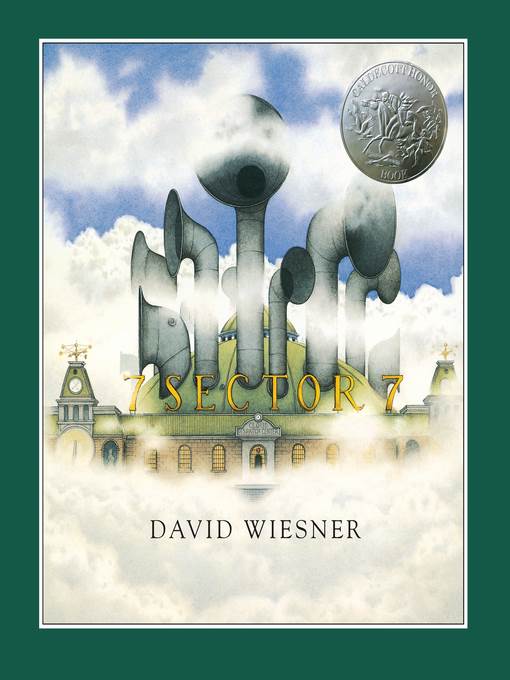
Sector 7
کتاب های مرتبط
- اطلاعات
- نقد و بررسی
- دیدگاه کاربران
نقد و بررسی

Starred review from September 20, 1999
Caldecott Medalist Wiesner (Tuesday) again takes to the air, with watercolors that render words superfluous. Here, a boy on a class trip to the Empire State Building discovers that the landmark, enveloped by fog, is nonetheless a gateway to incredible vistas indeed. The boy is soon befriended by a jolly cloud that whisks him off to a sort of Grand Central in the sky, which functions as headquarters for clouds in the metro area--Sector 7. Giant tubes funnel the clouds in and out of a designated waiting area; boards overhead track arrivals and departures (e.g., "Altocumulus" Dep. 1:03, Tube 21W). Uniformed bureaucrats keep their eyes on the skies in various locations (Hoboken, Brooklyn, Manhattan, etc.) by means of TV-type monitors, and issue each departing cloud an architectural-type drawing with precisely delineated shapes and measurements to which it must conform. The complex is rendered with the hard edges and clear definition of ultra-realism, a style that serves as an effective foil for both the wispy clouds and the story's fantastical premise. Magnificent as the "Cloud Dispatch Center" is, it is only the beginning. For the boy, having discerned the clouds' dissatisfaction with their pedestrian assignments, alters the drawings and specs so that the clouds begin to transform into blowfish, angel fish and octopus shapes. Even after the unamused bureaucrats discover his creations and summarily return him by cloud taxi to his classmates, the boy's influence persists: an elaborate tropical-sea-in-the-sky astonishes his friends (and strangers on the street), draws fish to the surface of the river, and has the city's indoors cats pawing at their windowpanes in excitement. Starting from a simple, almost obvious idea--once one has thought of it--Wiesner offers up an ingenious world of nearly unlimited possibilities. His paintings, at once highly playful and purely pristine, contain such a wealth of details that they reveal new discoveries even after repeated examinations. The frame-within-a-frame that depicts the boy's first glimpse of the Sector 7 complex, for instance, is a mesmerizing study of the variegated colors and textures of clouds. The work as a whole is an inspired embodiment of what seems to be this artist's approach to story and vision: the more you look, the more there is to see. Ages 5-up.

December 1, 1999
K-Gr 4-A playful mist transports a schoolboy from the observation deck of the Empire State Building to a colossal cloud factory. Intricate watercolors convey the wonder and whimsy of this magical adventure. (Sept.)
Copyright 1999 Library Journal, LLC Used with permission.

Starred review from September 1, 1999
Gr 1-4-Wiesner's fans will be on Cloud 9 with this wordless scenario of a class trip to the Empire State Building. An initial visual clue of the drama is a fullpage illustration before the title page of a boy drawing sea creatures on the frosted windowpane of a school bus. On the top observation deck amid hovering clouds, the boy's red scarf and hat are spirited off and onto a white, puffy cloud figure (whose face is a cross between Little Toot and Casper the Ghost). The boy's new cloud pal transports him to Sector 7 and the Cloud Dispatch Center, where, akin to a train station, arrivals and departures are scheduled. The boy is introduced to other cloud forms and learns how they are shaped and channeled across the country as designated by individual blueprints. When the artistic youngster draws fanciful fish and the clouds assume their shapes, the dispatchers are shocked and ban the boy from the sector. His cloud pal returns him to the class outing, where he floats off the elevator onto the school bus. The climatic finish amuses and puzzles everyone in the story and will delight readers. The artist's fascination with floating and flying escapades is as free spirited and frolicsome as in his Tuesday (Clarion, 1991), Free Fall (Lothrop, 1988), and June 29, 1999 (Clarion, 1992). The framed panels have a cinematic quality that sweeps readers off into the clouds along with the boy. This wittily depicted stretch of the imagination displays Wiesner's talent in top form.-Julie Cummins, New York Public Library
Copyright 1999 School Library Journal, LLC Used with permission.

September 15, 1999
Ages 5^-9. Although Wiesner's latest picture-book fantasy appears at first to be wordless, it actually has some words that are quite important. On a class trip to the Empire State Building, a boy who likes to draw is approached by a friendly cloud who takes him to Sector 7, a "terminal" reminiscent of a train station in the sky, where clouds form according to blueprints drawn up by grumpy, unimaginative humans. It seems the clouds are itching for a makeover, and the boy, pencil and paper in hand, gives it to them. Because words such as "terminal," "arrivals," and "assignment station," which appear on signs in the pictures, are necessary to establish the scene in some instances, younger children may need adult help with the book. There are also a few glitches that observant kids might notice. Why, for example, has the boy's art pad been switched to his left pocket in one picture? But the clever sometimes overlapping illustrations are wonderful: strong and precise, they range from detailed, realistic renderings of places and human characters to pictures of fluffy clouds, at once diaphanous and substantial, complete with expressive faces, and fat, fascinating four-fingered hands. A book for somewhat older children than the ones who "read" books by John Goodall and his ilk, but a good choice for getting the imagination to work. ((Reviewed September 15, 1999))(Reprinted with permission of Booklist, copyright 1999, American Library Association.)

























دیدگاه کاربران